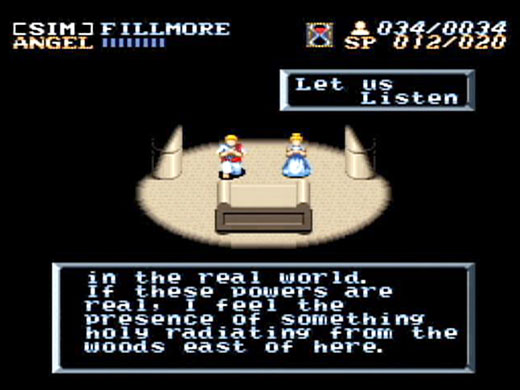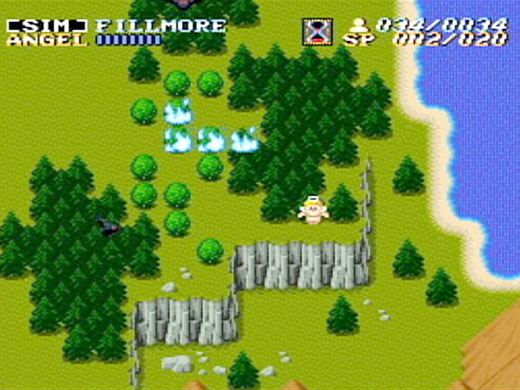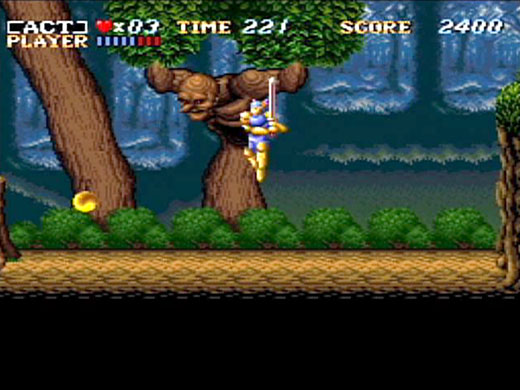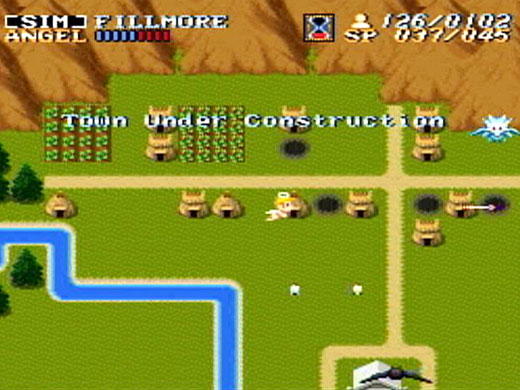I recently revisited the Super NES’s ambitious hybrid adventure ActRaiser, playing it to completion for the first time in decades. For the first time, I experienced it as someone heavily invested in studying game design rather than just as a kid who likes video games. Even with this change in perspective, I found the game holds up remarkable well. ActRaiser may be imperfect, but it’s nevertheless brilliant.
Advertisement
More than 25 years after its debut, ActRaiser remains unique, not only within the Super NES library but in gaming as a whole. The closest thing it has to successors would probably be Level-5's Dark Cloud 2 or perhaps Dragon Quest Builders, both of which also blend of role-playing, simulation, and action elements. Yet it still stands distinct from those games. ActRaiser’s treatment of religion, which goes well beyond mere fire-and-brimstone visions of deity and power, has proven every bit as unusual as its genre-bending design.ActRaiser exemplifies the power of creative synthesis. Taken individually, its components would amount to merely so-so takes on their respective genres. As a side-scrolling action game, it feels entirely too short for its own good. It’s also quite poorly balanced. Some of the magic spells you uncover throughout the course of the quest essentially function as instant-win buttons—buttons you'll be tempted to abuse given how difficult the stiff controls can make certain boss encounters.The simulation sequences wouldn't be much better on their own, giving players only six tiny, self-contained pieces of land to cultivate. There's no real strategy to developing land, as your villagers automatically build the best structures they know how, and the potential for each land's end-state is so finite that you can follow a prescribed sequence of development to create the same optimal build every single time. Civilization VI this isn't.
Advertisement
Yet ActRaiser's middling components somehow work together better in practice than they would seem to on paper. Developer Quintet played to its strengths with ActRaiser; the studio had come into existence as a coalition of emigres from action-RPG pioneer Nihon Falcom, and for the studio's debut project they drew on their experience with simple but effective role-playing elements as a way to bind everything together.ActRaiser's sim phases enhance the player's combat stats, with population growth serving the role of traditional RPG experience points. You also uncover most of your powers for use in the action phases during sim sequences. Meanwhile, completing each of the dozen or so action-based levels unlocks new features and lands to cultivate during the sim portions. This creates a constant, gentle, back-and-forth relationship between the two halves that gives ActRaiser the "one more turn" compulsiveness all the best strategy games possess.Unlike so many of it’s sim contemporaries, Actraiser also possessed a driving narrative. You, the godlike Master, were defeated by the demon Tanzra 1000 years ago, and now you've returned to drive back these demons and help humanity repopulate the world. It's at the smaller scale where ActRaiser's narrative truly shines. Each land has its own plot arc, and your nameless supplicants approach you with a series of surprisingly affecting vignettes. The breakdown of the story structure shares a lot in common with the Dragon Quest games—not coincidentally the best-selling franchise for ActRaiser publisher Enix—and all of these micro-tales go a long way toward humanizing a genre that normally treats people as abstractions.
Advertisement

Looking at the game with fresh eyes, I’ve found myself impressed by its cohesiveness. Yet the game also resonated with me when I played it as a kid who was only just coming to appreciate RPGs—a kid whose only experience with simulations to that point had been marveling at the complexity of a friend's copy of SimEarth. It was the story that grabbed me back when I first played it, and not just the underlying humanity of it. ActRaiser spoke to me because it was the first Nintendo game that I'd ever been able to relate to as a wholesome, church-going, Christian kid.Prior to ActRaiser, I'd never come across a video game that touched on Judeo-Christian concepts, let alone revolved around them. It played fast and loose with biblical text, sure, but there was no mistaking the ideas at play. ActRaiser did a remarkable job of translating Old Testament religion into interactive form.Yes, you had your god of fire and brimstone as your avatar (the Master) descended to earth and slashed his way through demon hordes, but ActRaiser also took a more nuanced approach to the Master's relationship to His people that reflected the majority of the Old Testament's text. The hopes and dreams of the people who come to the temple at the center of each land to make requests and deliver offerings to the Master echo familiar biblical vignettes.You don't have to strain to see the connection between, say, the prayers of parents desperate to prevent their son from being offered as a sacrifice to placate a demon and Abraham's reluctant sacrifice of Isaac, or to connect ActRaiser's people led astray by false prophets with the challenges Moses faced in leading the Israelites through their decades-long exile in the wilderness.
Advertisement

Of course, ActRaiser also involves light shoot-em-up elements in which a Cupid-like cherub guns down dragons and giant skulls with heart-shaped arrows. It takes its share of liberties, in other words.Yet, at the time, its unflinching exploration of religious themes and spirituality (conveyed through one of the first genuinely excellent Japanese-to-English localizations ever to grace a video game) meant a lot to me, because being a kid who went to church every week was a big part of who I was. Religion and video games were two parts of my identity that rarely mingled, especially as I began to gravitate toward RPGs.I grew up in Lubbock, a particularly conservative city in West Texas that had practically been ground zero in the national crusade against Dungeons & Dragons throughout the ’80s; one of our local police detectives traveled the country speaking out against the satanic dangers of RPGs. So to find an RPG-like game that literally put you on God's side to face down what amounted to Satan in a story that flirted with premillennialist concepts felt like vindication.Of course, I'm sure many of the more stern-faced elders in my church would have regarded a game in which you play as God's avatar to be blasphemy, but I knew enough even as a teenager to understand that there's just no pleasing some people.

What I didn't realize back then was that ActRaiser was far from the first Nintendo game I'd played that included Christian imagery. Japanese developers tended to treat Western religions with the same blundering, outsider enthusiasm which which, say, American comics writers import ninja and samurai into their work. Western religions certainly have their share of practitioners in Japan, but those faiths still have an air of exoticism about them: Vaguely familiar, yet foreign enough to spice up a work with a dash of mystery.
Advertisement
Nintendo of America, however, launched the Nintendo Entertainment System well aware of the Christian heritage that runs through U.S. society and the complications that products like D&D had experienced throughout the conservative-leaning ’80s. So, the company took a hard-line stance on religious imagery: If it reflects a real-world faith, get rid of it. Be it crosses, Stars of David, utterances of prayers, invocations of deities, it all got scrubbed out in translation.That practice even affected ActRaiser. In the original Japanese text, the demon Tanzra is openly called Satan, and the Master is unequivocally cast as a Judeo-Christian take on God. Nintendo naturally demanded Enix of America scrub those details out of the localized text, just as the devil's name in Capcom's Ghosts ’N Goblins series became "Rushifell" and "Sardius" on consoles. But ActRaiser's themes and references came through regardless. Nintendo had erected a proverbial dam to contain the flow of potentially offensive religious concepts from entering the U.S., but ActRaiser's literal interpretation of the god-sim genre burst through those flimsy bulwarks. The entire game is suffused with Old Testament motifs, and it revolves around the idea of a powerful yet caring deity. There's no getting around all of that with a few name changes.Around the same time ActRaiser launched in the U.S., Acclaim brought over the Super NES conversion of Peter Molyneux's Populous, another literal god-sim. While that game's religious themes didn't run as deeply as those in ActRaiser (due largely to its almost complete lack of a narrative beyond "destroy the enemy civilization"), Populous nevertheless got away with more than had ever slipped through the net in the 8-bit days. A key element of the game's strategy had to do with the placement of a "Papal Magnet," a religious icon that would allow you to turn a settler into a Crusader, basically. The Papal Magnet appeared on-screen as an ankh rather than a cross, but the intent came through clearly in Populous just as it had with Ultima's similar use of the Egyptian symbol.
Advertisement

In the years to come, Nintendo would loosen up its restrictions on content. As more explicitly violent and even nebulously sexual material would make its way to Nintendo consoles, so too would overtly religious material. Edmund McMillen's The Binding of Isaac—a game that dives right into themes of violence, sexuality, and religion—even showed up for Switch's launch last year. The change in Nintendo's attitude toward edgy material has changed as a result of a great many factors, but I can't help but feel that ActRaiser played some small part in the process. It let kids fight Satan, as God, and we all turned out fine.It's interesting to look back at Quintet's Super NES catalog; of the six games the company produced for that platform, only one didn't revolve around religious or creationist themes. However, ActRaiser would be their only project to embrace predominantly Judeo-Christian motifs. Beginning with 1992's SoulBlazer, Quintet shifted its spirituality further east, settling on animistic themes reminiscent of Shinto.As for myself, my own religious orientation has drifted from Christianity to more of a nebulous agnosticism over time. I certainly hold dear the spiritual values I was brought up to believe in: Compassion, charity, forgiveness. But not so much the literal text of the scriptures. And yet, all this time later, I still find that ActRaiser speaks to me.When you complete the game, defeating Tanzra and bringing your civilizations to their maximized state, you continue to observe your believers. There's no real interaction left, though, and nothing more that you can do as a caring god to help your mortal children. The game ends with you and your angel helper checking in on the final prayer shrine in Northwall only to find it empty."As cultures and lands become more advanced, do people tend to forget those who helped them?" the angel ponders aloud. "People may be most happy when not in need of help from their master, or when they have forgotten him. Should we yearn for a time when people will no longer need to ask for our help?" 25 years after the game first presented me with this question, I still find myself contemplating it.Have thoughts? Swing by Waypoint’s forums to share them!